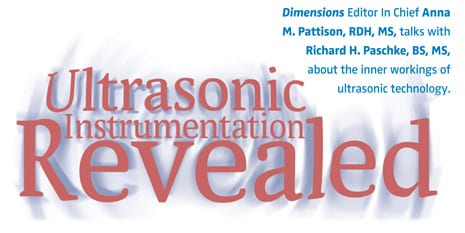
Ultrasonic Instrumentation Revealed
Dimensions Editor in Chief Anna M. Pattison, RDH, MS, talks with Richard H. Paschke, BS, MS, about the inner workings of ultrasonic technology.
Q. When a clinician adjusts the power setting on an automatically tuned magnetostrictive or piezoelectric ultrasonic scaler, are both the frequency and the amplitude affected?
A. No. When a clinician adjusts the power setting on an automatically tuned system, regardless of whether it’s a magnetostrictive or a piezoelectric system, only the amplitude is affected. Slight changes in frequency may occur, depending on how the electronics function, but typically the changes are very small and inconsequential.
Q. What is the difference between frequency and amplitude and how do each of these affect the performance of the tip?
A. Frequency is a measure of how many times the tip moves back and forth during one cycle. This is usually measured in seconds. The amplitude is a measure of the distance the tip travels during its back and forth movement. Frequency and amplitude work together to determine cleaning efficacy, assuming the tips are identical. The speed is probably the best predictor of how well the tip will work. The speed of the tip is determined by multiplying the amplitude by the frequency. For example, the speed of an automobile is referred to as miles per hour. In an ultrasonic system, the ranges are much lower but the principle is the same—either thousandths of an inch per second or microns per second.
Q. Is a higher frequency more powerful than a lower frequency?
A. No, this is a common misconception. A higher frequency is not necessarily more powerful. It simply means the tip is moving back and forth more times in a second. Power is a function of several factors—tip shape, amplitude, frequency, tip pressure against the tooth, and the angle of the pressure.
Q. Do manually tuned magnetostrictive ultrasonic scaling units perform better than automatically tuned units?
 A. There’s no reason that a manually tuned system should work better than an automatically tuned system. Normally, system performance is optimized by driving the insert or tip at the frequency that produces the maximum amplitude for any given power setting. In a manually tuned system, the clinician is responsible for finding the optimum level. Some discussion exists on how to determine this. Should sound be used or a spray pattern? Both are effective. But the bottom line is that the manually tuned system requires a decision on the part of the clinician to bring it to the same optimum level that the automatic system does routinely.
A. There’s no reason that a manually tuned system should work better than an automatically tuned system. Normally, system performance is optimized by driving the insert or tip at the frequency that produces the maximum amplitude for any given power setting. In a manually tuned system, the clinician is responsible for finding the optimum level. Some discussion exists on how to determine this. Should sound be used or a spray pattern? Both are effective. But the bottom line is that the manually tuned system requires a decision on the part of the clinician to bring it to the same optimum level that the automatic system does routinely.
Q. How can tip performance be improved?
A. Tip performance starts with tip design. The clinical application should determine the basic design. For example, the size and basic shape of the tip should be determined by the access and adaptation requirements. This includes the thickness of the tip, the shape and length of the working portion of the tip, and the distance of the tip from the end of the handpiece (piezoelectric) or the grip area (magnetostrictive). A tip with an edge, eg, type 1000 with a suitable working tip length or any piezoelectric tip with an edge, will be more efficient in removing deposits than a round tip shape. Next, the material used to make the tip should be selected to assure robust performance. This includes the ability to remove deposits using the manufacturer’s recommended power levels, a high resistance to breakage, and a reasonable resistance to wear (long service life).
Q. How do the thickness of tips or inserts and the level of power affect the performance?
A. A thicker tip at a high power level has a slightly greater cleaning power than a thinner tip with the same tip shape when used under the same operating conditions. At lower power settings, this difference is probably not significant. The challenge is that many thinner tips cannot typically be used at higher power levels because of the risk of breakage. Since thinner tips are selected on the basis of access and tip shape for adaptation, a well-designed thin tip that can be safely operated at higher power levels would be desirable. More research and development on insert design and materials to create thin tips that work efficiently on tenacious calculus are needed. The cleaning effectiveness for all tip styles is enhanced by operating the tip or insert in an electronic unit that has the ability to maintain amplitude and frequency under clinical operating conditions. In principle, the speed (amplitude times frequency) has a greater effect on performance than the size of the tip.
From Dimensions of Dental Hygiene. February 2007;5(2): 28-29.

